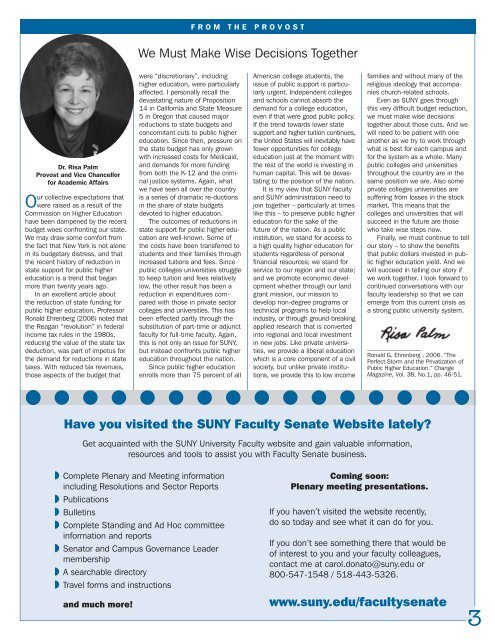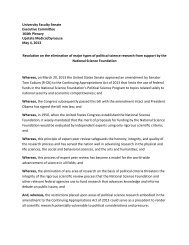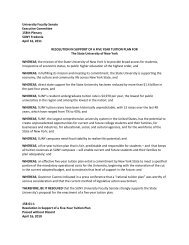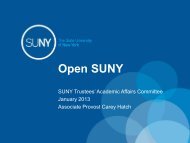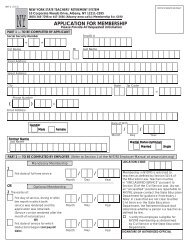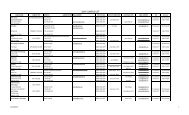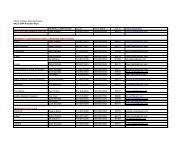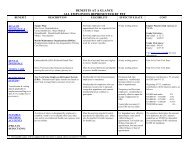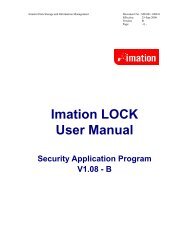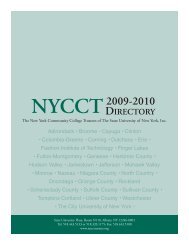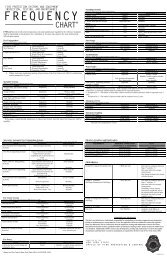Layout 1 copy - The State University of New York
Layout 1 copy - The State University of New York
Layout 1 copy - The State University of New York
You also want an ePaper? Increase the reach of your titles
YUMPU automatically turns print PDFs into web optimized ePapers that Google loves.
F R O M T H E P R O V O S T<br />
We Must Make Wise Decisions Together<br />
Dr. Risa Palm<br />
Provost and Vice Chancellor<br />
for Academic Affairs<br />
Our collective expectations that<br />
were raised as a result <strong>of</strong> the<br />
Commission on Higher Education<br />
have been dampened by the recent<br />
budget woes confronting our state.<br />
We may draw some comfort from<br />
the fact that <strong>New</strong> <strong>York</strong> is not alone<br />
in its budgetary distress, and that<br />
the recent history <strong>of</strong> reduction in<br />
state support for public higher<br />
education is a trend that began<br />
more than twenty years ago.<br />
In an excellent article about<br />
the reduction <strong>of</strong> state funding for<br />
public higher education, Pr<strong>of</strong>essor<br />
Ronald Ehrenberg (2006) noted that<br />
the Reagan “revolution” in federal<br />
income tax rules in the 1980s,<br />
reducing the value <strong>of</strong> the state tax<br />
deduction, was part <strong>of</strong> impetus for<br />
the demand for reductions in state<br />
taxes. With reduced tax revenues,<br />
those aspects <strong>of</strong> the budget that<br />
were “discretionary”, including<br />
higher education, were particularly<br />
affected. I personally recall the<br />
devastating nature <strong>of</strong> Proposition<br />
14 in California and <strong>State</strong> Measure<br />
5 in Oregon that caused major<br />
reductions to state budgets and<br />
concomitant cuts to public higher<br />
education. Since then, pressure on<br />
the state budget has only grown<br />
with increased costs for Medicaid,<br />
and demands for more funding<br />
from both the K-12 and the criminal<br />
justice systems. Again, what<br />
we have seen all over the country<br />
is a series <strong>of</strong> dramatic re-ductions<br />
in the share <strong>of</strong> state budgets<br />
devoted to higher education.<br />
<strong>The</strong> outcomes <strong>of</strong> reductions in<br />
state support for public higher education<br />
are well-known. Some <strong>of</strong><br />
the costs have been transferred to<br />
students and their families through<br />
increased tuitions and fees. Since<br />
public colleges universities struggle<br />
to keep tuition and fees relatively<br />
low, the other result has been a<br />
reduction in expenditures compared<br />
with those in private sector<br />
colleges and universities. This has<br />
been effected partly through the<br />
substitution <strong>of</strong> part-time or adjunct<br />
faculty for full-time faculty. Again,<br />
this is not only an issue for SUNY,<br />
but instead confronts public higher<br />
education throughout the nation.<br />
Since public higher education<br />
enrolls more than 75 percent <strong>of</strong> all<br />
American college students, the<br />
issue <strong>of</strong> public support is particularly<br />
urgent. Independent colleges<br />
and schools cannot absorb the<br />
demand for a college education,<br />
even if that were good public policy.<br />
If the trend towards lower state<br />
support and higher tuition continues,<br />
the United <strong>State</strong>s will inevitably have<br />
fewer opportunities for college<br />
education just at the moment with<br />
the rest <strong>of</strong> the world is investing in<br />
human capital. This will be devastating<br />
to the position <strong>of</strong> the nation.<br />
It is my view that SUNY faculty<br />
and SUNY administration need to<br />
join together – particularly at times<br />
like this – to preserve public higher<br />
education for the sake <strong>of</strong> the<br />
future <strong>of</strong> the nation. As a public<br />
institution, we stand for access to<br />
a high quality higher education for<br />
students regardless <strong>of</strong> personal<br />
financial resources; we stand for<br />
service to our region and our state;<br />
and we promote economic development<br />
whether through our land<br />
grant mission, our mission to<br />
develop non-degree programs or<br />
technical programs to help local<br />
industry, or through ground-breaking<br />
applied research that is converted<br />
into regional and local investment<br />
in new jobs. Like private universities,<br />
we provide a liberal education<br />
which is a core component <strong>of</strong> a civil<br />
society, but unlike private institutions,<br />
we provide this to low income<br />
families and without many <strong>of</strong> the<br />
religious ideology that accompanies<br />
church-related schools.<br />
Even as SUNY goes through<br />
this very difficult budget reduction,<br />
we must make wise decisions<br />
together about those cuts. And we<br />
will need to be patient with one<br />
another as we try to work through<br />
what is best for each campus and<br />
for the system as a whole. Many<br />
public colleges and universities<br />
throughout the country are in the<br />
same position we are. Also some<br />
private colleges universities are<br />
suffering from losses in the stock<br />
market. This means that the<br />
colleges and universities that will<br />
succeed in the future are those<br />
who take wise steps now.<br />
Finally, we must continue to tell<br />
our story – to show the benefits<br />
that public dollars invested in public<br />
higher education yield. And we<br />
will succeed in telling our story if<br />
we work together. I look forward to<br />
continued conversations with our<br />
faculty leadership so that we can<br />
emerge from this current crisis as<br />
a strong public university system.<br />
__________________<br />
Ronald G. Ehrenberg , 2006. “<strong>The</strong><br />
Perfect Storm and the Privatization <strong>of</strong><br />
Public Higher Education.” Change<br />
Magazine, Vol. 38, No.1, pp. 46-51.<br />
Have you visited the SUNY Faculty Senate Website lately?<br />
Get acquainted with the SUNY <strong>University</strong> Faculty website and gain valuable information,<br />
resources and tools to assist you with Faculty Senate business.<br />
◗<br />
◗<br />
◗<br />
◗<br />
◗<br />
◗<br />
◗<br />
Complete Plenary and Meeting information<br />
including Resolutions and Sector Reports<br />
Publications<br />
Bulletins<br />
Complete Standing and Ad Hoc committee<br />
information and reports<br />
Senator and Campus Governance Leader<br />
membership<br />
A searchable directory<br />
Travel forms and instructions<br />
and much more!<br />
Coming soon:<br />
Plenary meeting presentations.<br />
If you haven’t visited the website recently,<br />
do so today and see what it can do for you.<br />
If you don’t see something there that would be<br />
<strong>of</strong> interest to you and your faculty colleagues,<br />
contact me at carol.donato@suny.edu or<br />
800-547-1548 / 518-443-5326.<br />
www.suny.edu/facultysenate<br />
3


